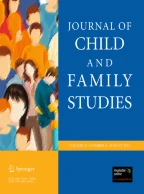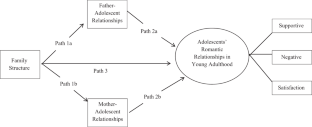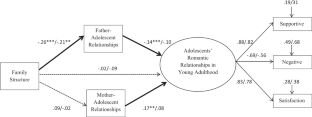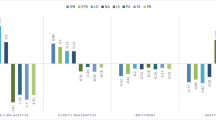Romantic Relationships in Young Adulthood: Parental Divorce, Parent-child Relationships during Adolescence, and Gender

The current study aimed to examine the role of parent-child relationships during adolescence as a mediator between earlier parental divorce and children's romantic relationships in emerging adulthood. In addition, the study aimed to examine how this proposed mediation model would work differently among the four dyads of parent-child based on their gender (e.g., father-daughter vs. mother-son). The data for this study came from a 22-year 9-wave investigated longitudinal study, which began when the participants were in the sixth grade. The study was designed to investigate transitions during adolescence and young adulthood. Analyses for the current study were based on waves 6 and 8. At Wave 6, participants were in 12th grade and at Wave 8, participants were approximately 24 years old. The sample for the current study was 520 (female = 311 and male = 209) from 'always-married' and 154 (female = 107 and male = 47) from 'divorced' families. In order to examine the mediation model for each female and male adolescents, multi-group confirmatory factor analysis (MGCFA) was tested using Structural Equation Modeling (SEM) - LISREL Version 8.80. The results showed that there was no overall direct mediation model; however, the mediation model worked differently for the four dyads of parent-child. For example, it was found that there was an indirect effect of parental divorce through relationships with fathers on daughters' romantic relationships but not for sons. Implications, limitations, and future research recommendations are discussed.
This is a preview of subscription content, log in via an institution to check access.
Access this article
Subscribe and save
Springer+ Basic
€32.70 /Month
- Get 10 units per month
- Download Article/Chapter or eBook
- 1 Unit = 1 Article or 1 Chapter
- Cancel anytime
Buy Now
Price includes VAT (France)
Instant access to the full article PDF.
Rent this article via DeepDyve


Similar content being viewed by others
Parental Divorce, Relationships with Fathers and Mothers, and Children’s Romantic Relationships in Young Adulthood
Article 17 November 2017
A Developmental Perspective on Young Adult Romantic Relationships: Examining Family and Individual Factors in Adolescence
Article 13 February 2018

Exploring psychosocial adjustment profiles in Chinese adolescents from divorced families: The interplay of parental attachment and adolescent’s gender
Article 28 September 2020
References
- Ainsworth, M. S., & Bowlby, J. (1991). An ethological approach to personality development. American Psychologist, 46, 333–341. ArticleGoogle Scholar
- Amato, P. R. (1996). Explaining the intergenerational transmission of divorce. Journal of Marriage and Family, 58, 628–640. ArticleGoogle Scholar
- Amato, P. R., & Rodgers, S. J. (1999). Do attitudes toward divorce affect marital quality? Journal of Family Issues, 20, 69–86. ArticleGoogle Scholar
- Auslander, B. A., Short, M. B., Succop, P. A., & Rosental, S. L. (2009). Associations between parenting behaviors and adolescent romantic relationships. Journal of Adolescent Health, 45, 98–101. ArticlePubMedGoogle Scholar
- Baggett, E., Shaffer, A., & Muetzelfeld, H. (2015). Father-daughter parentification and young adult romantic relationships among college women. Journal of Family Issues, 36, 760–783. ArticleGoogle Scholar
- Bandura, A. (1986). Social foundations of thought and action: A social cognitive theory. Upper Saddle River, NJ: Prentice-Hall. Google Scholar
- Baron, R. M., & Kenny, D. A. (1986). The moderator-mediator variable distinction in social psychological research: conceptual, strategic, and statistical considerations. Journal of Personality and Social Psychology, 51, 1173–1182. ArticlePubMedGoogle Scholar
- Bastaits, K., Ponner, K., & Mortelmans, D. (2012). Parenting of divorced fathers and the association with children’s self-esteem. Journal of Youth and Adolescence, 41, 1643–1656. ArticlePubMedGoogle Scholar
- Bastaits, K., Ponner, K., & Mortelmans, D. (2014). Do divorced fathers matter? The impact of parenting styles of divorced fathers on the well-being of the child. Journal of Divorce and Remarriage, 55, 1–27. ArticleGoogle Scholar
- Beelmann, W., & Schmidt-Denter, U. (2009). Mother-child interaction following marital separation: a longitudinal observation study. European Psychologist, 14, 307–319. ArticleGoogle Scholar
- Biller, H. B., & Kimpton, J. L. (1997). The father and the school-aged child. In M. E. Lamb (Ed.), The role of the father in child development (pp. 143–161). New York: Wiley.
- Braithwaite, S. R., Delevi, R., & Fincham, F. D. (2010). Romantic relationships and the physical and mental health of college students. Personal Relationships, 17, 1–12. ArticleGoogle Scholar
- Braithwaite, S., Doxey, R., Dowdle, K. K., & Fincham, F. D. (2016). The unique influences of parental divorce and parental conflict on emerging adults in romantic relationships. Journal of Adult Development, 23, 214–225. ArticleGoogle Scholar
- Brotherson, S. E., Ymamoto, T., & Acock, A. C. (2003). Connection and communication in father-child relationships and adolescent child well-being. Fathering, 1, 191–214. ArticleGoogle Scholar
- Buehler, C., Benson, M. J., & Gerard, J. M. (2006). Interparental hostility and early adolescent problem behavior: the mediating role of specific aspects of parenting. Journal of Research on Adolescence, 16, 265–292. ArticleGoogle Scholar
- Burns, A., & Dunlop, R. (1998). Parental divorce, parent-child relations, and early adult relationships: a longitudinal Australian study. Personal Relationships, 5, 393–407. ArticleGoogle Scholar
- Carlson, M. J. (2006). Family structure, father involvement, and adolescent behavioral outcomes. Journal of Marriage and Family, 68, 137–154. ArticleGoogle Scholar
- Cavanagh, S. E., Crissey, S. R., & Raley, R. K. (2008). Family structure history and adolescent romance. Journal of Marriage and Family, 70, 698–714. ArticleGoogle Scholar
- Center for Disease Control and Prevention. (2017). National marriage and divorce rate trends. https://www.cdc.gov/nchs/fastats/marriage-divorce.html
- Chen, H., Cohen, P., Kasen, S., Johnson, J. G., Ehrensaft, M., & Gordon, K. (2006). Predicting conflict within romantic relationships during transition to adulthood. Personal Relationships, 13, 411–427. ArticleGoogle Scholar
- Collins, N. L., & Feeney, B. C. (2004). Working models of attachment shape perceptions of social support. Journal of Personality and Social Psychology, 87, 363–383. ArticlePubMedGoogle Scholar
- Conger, R. D., Cui, M., Bryant, C. M., & Elder, Jr., G. H. (2000). Competence in early adult romantic relationships: a developmental perspective on family influences. Journal of Personality and Social Psychology, 79, 224–237. ArticlePubMedGoogle Scholar
- Cui, M., & Fincham, F. D. (2010). The differential effects of parental divorce and marital conflict on young adult romantic relationships. Personal Relationships, 17, 331–343. ArticleGoogle Scholar
- Dalton, III., W. T., Frick-Horbury, D., & Kitzmann, K. M. (2006). Young adults’ retrospective reports of parenting by mothers and fathers: associations with current relationship quality. Journal of General Psychology, 133, 5–18. ArticlePubMedGoogle Scholar
- Freeman, H., & Almond, T. M. (2010). Mapping young adults’ use of fathers for attachment support: Implications on romantic relationship experiences. Early Child Development and Care, 180, 227–248. ArticleGoogle Scholar
- Gahler, M., Hong, Y., & Bernhardt, E. (2009). Parental divorce and union disruption among young adults in Sweden. Journal of Family Issues, 30, 688–713. ArticleGoogle Scholar
- Gonzales, N. A., Cauce, A. M., & Mason, C. A. (1996). Interobserver agreement in the assessment of parental behavior and parent-adolescent conflict: African mothers, daughters, and independent observers. Child Development, 67, 1483–1498. ArticlePubMedGoogle Scholar
- Hakvoort, E. M., Bos, H. M. W., Van Balen, F., & Hermanns, J. M. A. (2011). Postdivorce relationships in families and children’s psychosocial adjustment. Journal of Divorce and Remarriage, 52, 125–146. ArticleGoogle Scholar
- Hauser, S. T., Book, B. K., Houlihan, J., Powers, S., Weiss-Perry, B., Follansbee, D., Jacobson, A. M., & Noam, G. G. (1987). Sex differences within the family: studies of adolescent and parent family interactions. Journal of Youth and Adolescence, 16, 199–220. ArticlePubMedGoogle Scholar
- Hetherington, E. M. (1989). Coping with family transitions: winners, losers, and survivors. Child Development, 60, 1–14. ArticlePubMedGoogle Scholar
- Heifetz, M., Connolly, J., Pepler, D., & Craig, W. (2010). Family divorce and romantic relationships in early adolescence. Journal of Divorce & Remarriage, 51, 366–378. ArticleGoogle Scholar
- Helweg-Laresen, M., Harding, H. G., & Klein, W. M. P. (2011). Will I divorce or have a happy marriage? Gender differences in comparative optimism and estimation of personal changes among U.S. college students. Basic and Applied Social Psychology, 33, 157–166. ArticleGoogle Scholar
- Herzog, M. J., & Cooney, T. M. (2002). Parental divorce and perceptions of past interparental conflict: influences on the communication of young adults. Journal of Divorce & Remarriage, 36, 89–109. ArticleGoogle Scholar
- Jacquet, S. E., & Surra, C. A. (2001). Parental divorce and premarital couples: commitment and other relationship characteristics. Journal of Marriage and Family, 63, 627–638. ArticleGoogle Scholar
- Kapinus, C. A. (2004). The effect of parents’ attitudes toward divorce on offspring’s attitudes: gender and parental divorce as mediating factors. Journal of Family Issues, 25, 112–135. ArticleGoogle Scholar
- Kaufman, G., & Uhlenberg, P. (1998). Effects of life course transitions on the quality of relationships between adult children and their parents. Journal of Marriage and Family, 60, 924–938. ArticleGoogle Scholar
- King, V. (2002). Parental divorce on interpersonal trust in adult offspring. Journal of Marriage and Family, 64, 642–656. ArticleGoogle Scholar
- Kline, R. B. (1998). Principles and practices of structural equation modeling. New York: Guilford. Google Scholar
- Linder, J. R., Crick, N. R., & Collins, W. A. (2002). Relational aggression and victimization in young adults’ romantic relationships: associations with perceptions of parent, peer, and romantic relationship quality. Social Development, 11, 69–86. ArticleGoogle Scholar
- Little, T. D. (1997). Mean and covariance structures (MACS) analyses of cross-cultural data: practical and theoretical issues. Multivariate Behavioral Research, 32, 53–76. ArticlePubMedGoogle Scholar
- MacCallum, R. C., Browne, M. W., & Sugawara, H. M. (1996). Power analysis and determination of sample size for covariance structural modeling. Psychological Methods, 2, 130–169. ArticleGoogle Scholar
- Masarik, A. S., Conger, R. D., Donnellan, M. B., Stallings, M. C., Martin, M. J., Scholfield, T. J., Neppl, T. K., Scaramella, L. V., Smolen, A., & Wildaman, K. F. (2014). For better and for worse: genes and parenting interact to predict future behavior in romantic relationships. Journal of Family Psychology, 28, 357–367. ArticlePubMedGoogle Scholar
- Meuwly, N., & Schoebi, D. (2017). Social psychological and related theories on long-term committed romantic relationships. Evolutionary Behavioral Sciences, 11, 106–120. ArticleGoogle Scholar
- Mustonen, U., Huurre, T., Kiviruusu, O., Haukkala, A., & Aro, H. (2011). Long-term impact of parental divorce on intimate relationship quality in adulthood and the mediating role of psychosocial resources. Journal of Family Psychology, 25, 615–619. ArticlePubMedGoogle Scholar
- O’Connor, T. G., Matias, C., Futh, A., Tantam, G., & Scott, S. (2013). Social learning theory parenting intervention promotes attachment-based caregiving in young children: randomized clinical trial. Journal of Clinical Child & Adolescent Psychology, 42, 358–370. ArticleGoogle Scholar
- Pazzagli, C., Delvecchio, E., Raspa, V., Mazzeschi, C., & Luyten, P. (2017). The parental reflective functioning questionnaire in mothers and fathers of school-aged children. Journal of Child and Family Studies, 27, 80–90. ArticleGoogle Scholar
- Riggio, H. R. (2004). Parental marital conflict and divorce, parent-child relationships, social support, and relationship anxiety in young adulthood. Personal Relationships, 11, 99–114. ArticleGoogle Scholar
- Riggio, H. R., & Valenzuela, A. M. (2011). Parental marital conflict and divorce, parent-child relationships, and social support among Latino-American young adults. Personal Relationships, 18, 392–409. ArticleGoogle Scholar
- Scott, S., Briskman, J., Woolgar, M., Humayun, S., & O’Conner, T. G. (2011). Attachment in adolescence: overlap with parenting and unique prediction of behavioural adjustment. The Journal of Child Psychology and Psychiatry, 52, 1052–1062. ArticlePubMedGoogle Scholar
- Seiffge-Krenke, I., Overbeek, G., & Vermulst, A. (2010). Parent-child relationships trajectories during adolescence: longitudinal associations with romantic outcomes in emerging adulthood. Journal of Adolescence, 33, 159–171. ArticlePubMedGoogle Scholar
- Shaw, D. S., Winslow, E. B., & Flanagan, C. (1999). A prospective study of the effects of marital status and family relations on young children’s adjustment among African American and European American families. Child Development, 70, 742–755. ArticlePubMedGoogle Scholar
- Shulman, S., Zlotnik, A., Shachar-Shapira, L., Connolly, J., & Bohr, Y. (2012). Adolescent daughter’s romantic competence: the role of divorce, quality of parenting, and maternal romantic history. Journal of Youth and Adolescence, 41, 593–606. ArticlePubMedGoogle Scholar
- Simons, L. G., Simons, R. L., & Burt, C. H. (2008). A test of explanations for the effect of harsh parenting on the perpertration of dating violence and sexual coercion. Violence and Victims, 23, 66–82. ArticlePubMedGoogle Scholar
- Simons, L. G., Simons, R. L., Landor, A. M., Bryant, C. M., & Beach, S. R. H. (2014). Factors linking childhood experiences to adult romantic relationships among African Americans. Journal of Family Psychology, 28, 368–379. ArticlePubMedPubMed CentralGoogle Scholar
- Tucker, C. J., Barber, B. L., & Eccles, J. S. (2001). Advice about life plans from mother, fathers, and siblings in always-married and divorced families during late adolescence. Journal of Youth and Adolescence, 30, 729–747. ArticleGoogle Scholar
- Walper, S., & Wendt, E.-V. (2015). Adolescents’ relationships with mother and father and their links to the quality of romantic relationships: a classification approach. European Journal of Developmental Psychology, 5, 516–532. ArticleGoogle Scholar
- Yu, T., Pettit, G. S., Lansford, J. E., Dodge, K. A., & Bates, J. E. (2010). The interactive effects of marital conflict and divorce on parent-adult children’s relationships. Journal of Marriage and Family, 72, 282–292. ArticlePubMedGoogle Scholar




